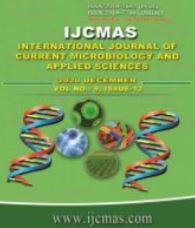


 National Academy of Agricultural Sciences (NAAS)
National Academy of Agricultural Sciences (NAAS)

|
PRINT ISSN : 2319-7692
Online ISSN : 2319-7706 Issues : 12 per year Publisher : Excellent Publishers Email : editorijcmas@gmail.com / submit@ijcmas.com Editor-in-chief: Dr.M.Prakash Index Copernicus ICV 2018: 95.39 NAAS RATING 2020: 5.38 |
Bacterial leaf blight on rice caused by Xanthomonas oryzae pv. oryzae (Xoo) is one most destructive disease on rice. The disease severity of this bacteria differs from geographical regions, strain (race) and the host genotype. Southern India grows rice and the disease incidence is very frequent as the climatic conditions are congenial for infections. However, the disease severity differs from place to place and efforts have made to understand the virulence efficiency of different isolates of Xoo from different locations of south India. All the isolates were successfully cultured in the laboratory and were confirmed by 16S rRNA sequencing. The sequence homology among the strains was similar except Xoo7 and has 99-100% homology with Xoo strain PXO99A. Based on nearest neighbor analysis first group of isolates are close to PXO61, OS198 and PXO 364 isolates from outside India. Second group with only Xoo7 is close to PXO513. Further the amounts of exopolysaccharide (EPS) produced were quantified that varied depending on Xoo isolates. The EPS were produced more by isolate Xoo5 followed by Xoo4, Xoo7 and Xoo10 and the least was in Xoo3. The pathogenicity assay among the Xoo isolate showed that all isolates were virulent and amongst them Xoo3 showed least necrotic lesions with less bacterial count (in planta). Further the presence of many effectors were confirmed by PCR analysis in all isolates, however the two Non-TAL effector genes XopP and XopV were not detected in any isolates. This study demonstrates that diversity in the Xoo infection exists among south Indian isolates and further the infection process of different isolates based on geographical region needs to be studied individually to develop resistance strategies against Xoo.
 |
 |
 |
 |
 |